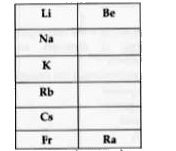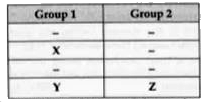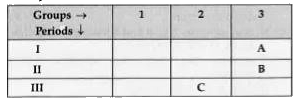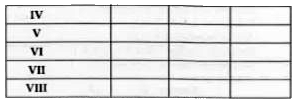TOPIC:2- LONG ANSWER TYPE QUESTIONS from OSWAAL CHEMISTRY (KANNADA ENGLISH) PERIODIC CLASSIFICATION OF ELEMENTS for Class 10
| Class 10 | CHEMISTRY |
| Chapter | PERIODIC CLASSIFICATION OF ELEMENTS |
| OSWAAL CHEMISTRY (KANNADA ENGLISH) | TOPIC:2- LONG ANSWER TYPE QUESTIONS |
| Medium | English |
| Academic Year | 2023-2024 |
Question 42
The atomic number of elements A, B, C, D and E are given below:

From the above table, answer the following questions :
(i) Which two elements are chemically similar ?
(ii) Which is an inert gas ?
(iii) Which element belongs to 3 period of periodic table ?
(iv) Which element among these is a non-metal ?View SolutionQuestion 45
Some of the elements and their atomic numbers are mentioned in the following table :
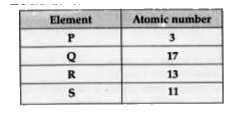
(i) How many valence electrons are there in the element 'R' ?
(ii) What is the valency of 'P' ?
(ii) Write the chemical formula of the compound formed by combining the elements ‘P' and 'Q'?
(iv) Out of the two elements 'P' and 'S', which one is larger in size ?View SolutionQuestion 47
The atomic numbers of five elements A, B, C, D and E are 6, 8, 3, 7 and 9 respectively.
(i) Which is the element having the highest electropositivity among these elements ? Why?
(ii) Which is the element having the least metallic character among these elements ? Why?
(iii) What is your conclusion about the relationship between metallic character and electropositivity of an element ?View SolutionQuestion 54
What is meant by a group in the Modern Periodic Table? How do the following change on moving from top to bottom in a group?
i] Number of valence electrons
ii] Number of occupied shells
iii] Size of atoms
iv] Metallic character of elements
v] Effective nuclear charge experienced by valence electrons View SolutionQuestion 58
An element 'M' with electronic configuration (2,8,2) combines separately with NO−3,SO2−4andPO3−4 radicals. Write the formula of the three compounds so formed. To which group and period of the modern periodic table does the element 'M' belong ? Will 'M' form covalent or ionic compounds? Give reason to justify your answer.View SolutionQuestion 59
Two elements P and Q belong to the 3rd period of the Modern Periodic Table and are in group 1 and 2 respectively. Compare their following characteristics in tabular form:
i] The number of electron in their atoms
ii] The size of their atoms
iii] Their metallic character
iv] Their tendencies to lose electrons
v] The formula of their oxides
vi] The formula of their chlorides.View SolutionQuestion 60
An element 'X' (Atomic number = 20) burns in the presence of oxygen to form a basic oxide.
(i) Identify the element and write its electronic configuration.
(ii) State its group number and period number in the Modern Periodic Table.
(iii) Write a balanced chemical equation for the reaction when this oxide is dissolved in water.View SolutionQuestion 61
An element 'X' belongs to third period and second group of the Modern Periodic Table.
(i) Write its electronic configuration.
(ii) Is it a metal or non-metal? Why?
(iii) Write the formula of the compound formed when 'X' reacts with an element
(a) Y of electronic configuration 2, 6 and (b) Z with electronic configuration 2, 8, 7.View SolutionQuestion 62
The atomic number of an element 'X' is 19.
(i) Write its electronic configuration.
(ii) To which period of the Modern Periodic Table does it belong and what is its valency?
(iii) If 'X' burns in oxygen to form its oxide, what will be its nature - acidic, basic or neutral ?
(iv) Write balanced chemical equation for the reaction when this oxide is dissolved in water.View SolutionQuestion 63
An element 'X' belongs to the 3rd period and group 16 of the Modern Periodic Table.
a) Determine the number of valence electrons and the valency of 'X'.
b] Write the molecular formula of the compound when X reacts with hydrogen and write its electron-dot structure.
c] Name the element X and state whether it is metallic or non-metallic View SolutionQuestion 65
Three elements 'X', 'Y' and 'Z' have atomic numbers 7, 8 and 9 respectively.
(i) State their positions (Group number and period number both) in the Modern Periodic Table.
(ii) Arrange these elements in the decreasing order of their atomic radii.
(iii) Write the formula of the compound formed when 'X' combines with 'Z'.View SolutionQuestion 66
The position of eight elements in the modern periodic table is given below where atomic numbers of elements are given in the parenthesis.
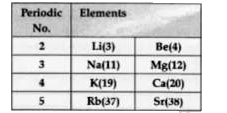
(i) Write the electronic configuration of Ca.
(ii) Predict the number of valence electrons in Rb.
(iii) What is the number of shells in Sr ?
(iv) Predict whether K is a metal or a non-metal.
(v) Which one of these elements has the largest atom in size ?
(vi) Arrange Be, Ca, Mg and Rb in the increasing order of the size of their respective atoms.View SolutionQuestion 67
Four elements A, B, C and D have atomic numbers 12, 13, 14 and 15 respectively.
Answer the following questions giving reasons :
(i) What is the number of valence electrons and valency of D?
(ii) Which of them will have largest atomic radii ?
(iii) Which of these elements will form the most basic oxide ?View SolutionQuestion 70
The elements _(4)Be,12Mgand20Ca each having two, valence electrons in their valence shells are in periods 2, 3 and 4 respectively of the modern periodic table. Answer the following questions associated with these elements, giving reason in each case,
(i) In which group should they be?
(ii) Which one of them is least reactive ?
(iii) Which one of them has the largest atomic size ?View SolutionQuestion 71
Two elements 'P' and 'Q' belong to the same period of the modern periodic table and are in Group -1 and Group -2 respectively. Compare their following characteristics in tabular form:
(i) The number of electrons in their atoms
(ii) The sizes of their atoms
(iii) Their metallic characters
(iv) Their tendencies to lose electrons
(v) The formula of their oxides
(vi) The formula of their chloridesView SolutionQuestion 72
The atomic number of an element 'X' is 20.
(i) Determine the position of the element 'X' in the periodic table.
(ii) Write the formula of the compound formed when 'X' reacts/combines with another element 'Y' (atomic number 8).
(iii) What would be the nature (acidic or basic) of the compound formed ? Justify your answer. View SolutionQuestion 73
Four elements P, Q, R and S belong to the third period of the Modern Periodic Table and have respectively 1,3,5 and 7 electrons in their outermost shells. Write the electronic configurations of Q and R and determine their valencies. Write the molecular formula of the compound formed when P and S combine.View SolutionQuestion 74
In the following table, the positions of six elements A, B, C, D, E and F are given as they are in the Modern Periodic Table :

On the basis of the above table, answer the following questions :
(i) Name the element which forms only covalent compounds.
(ii) Name the element which is a metal with valency three.
(iii) Name the element which is a non-metal with valency three.
(iv) Out of B and C, whose atomic radius is bigger and why?
(v) Write the common name for the family to which the elements D and F belong.View SolutionQuestion 75
The electrons in the atoms of four elements A, B, C and D are distributed in three shells having 1, 3, 5 and 7 electrons in the outermost shell respectively. State the period in which these elements can be placed in the modern periodic table. Write the electronic configuration of the atoms of A and D and the molecular formula of the compound formed when A and D combine.View SolutionQuestion 77
Consider two elements ‘A’ (Atomic number 17) and 'B' (Atomic number 19):
(i) Write the positions of these elements in the modern periodic table giving justification.
(ii) Write the formula of the compound formed when 'A' combines with 'B.'
(iii) Draw the electron dot structure of the compound and state the nature of the bond formed between the two elements.View SolutionQuestion 78
Study the following table in which positions of six elements A, B, C, D, E and F are shown as they are in the modern periodic table :
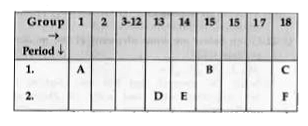
On the basis of the above table, answer the following questions :
(i) Name the element which forms only covalent compounds.
(ii) Name the element which is a metal with valency three.
(iii) Name the element which is a non-metal with valency three.
(iv) Out of D and E, which is bigger is size and why ?
(v) Write the common name for the family to which the elements C and F belong.View SolutionQuestion 79
The elements Li, Na and K, each having one valence electron, are in period 2, 3 and 4 respectively of modern periodic table.
(1) In which group of the periodic table should they be?
(ii) Which one of them is least reactive ?
(iii) Which one of them has the largest atomic radius?
Give reason to justify your answer in each case.View SolutionQuestion 81
Two elements X and Y belong to group 1 and 2 respectively in the same period of the periodic table. Compare these elements with respect to :
(i) number of electrons in their outermost orbit
(ii) their valencies
(iii) metallic character
(iv) their atomic size
(v) formula of their chlorides
(vii) formula of their sulphates. View SolutionQuestion 82
Four elements A, B, C and D along with their electronic configuration are given below:

Now answer the following questions:
(i) Which two elements belong to the same period ?
(ii) Which two elements belong to the same group ?
(iii) Which element out of A and C is more reactive and why?View SolutionQuestion 83
Four elements A, B, C and D have atomic numbers 12, 13, 14 and 15 respectively.
Answer the following questions giving reasons :
(i) What is the number of valence electrons and valency of D?
(ii) Which of them will have largest atomic radii ?
(iii) Which of these elements will form the most basic oxide ?View SolutionQuestion 85
From the following part of the periodic table, answer the following questions:
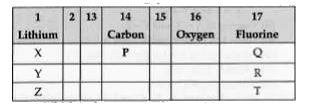
(i) Which is the most reactive metal ?
(ii) Name the family of fluorine Q, R, T.
(iii) Name one element each of group 2 and 15.
(iv) Give the name of the element P placed below carbon.
(v) Compare X and P with respect to the size of atoms.View SolutionQuestion 87
Given below are some elements of the Modern Periodic Table:
4Be,26Fe.14Si,19K20Ca
i) Select the element that has one electron in the outermost shell and write its electronic configuration.
ii) Select two elements that belong to the same group. Give reason.
iii) Select two elements that belong to the same period. Which one of the two has a bigger atomic size? View SolutionQuestion 90
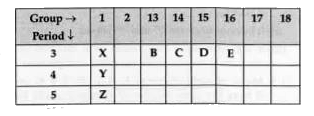
Using the given part of the periodic table, answer the following questions with reason :
(i) Name the element having smallest atomic size.
(ii) Write electronic configuration of element E.
(iii) Identify the elements which have similar physical and chemical properties as the element Y.View SolutionQuestion 92
Which element has :
(i) two shells, both of which are completely filled with electrons ?
(ii) the electronic configuration, 2, 8, 2.
(iii) a total of three shells, with four electrons in its valence shell ?
(iv) a total of two shells, with three electrons in its valence shell ?
(v) Twice as many electrons in its second shell as in its first shell ?View SolutionQuestion 93
An element is placed in 2nd group and 3rd period of the periodic table, burn in presence of oxygen to form a basic oxide :
(i) Identify the element
(ii) Write the electronic configuration
(iii) Write the balanced equation when it burns in the presence of air.
(iv) Write a balanced equation when this oxide is dissolved in water.
(v) Draw the electron dot structure for the formation of this oxide.View SolutionQuestion 95
Atoms of eight elements A, B, C, D, E, F, G and H have the same number of electronic shells but different in their outermost shells. It was found that elements A and G combine to form an ionic compound which can also be extracted from sea water.
Oxides of the elements A and B are basic in nature while those of E and F are acidic. The oxide of elements D is almost neutral.
Answer the following questions based on the information given here in :
(i) To which group or period of the periodic table do the listed elements belong ?
(ii) Which one of the eight elements is likely to be a noble gas?
(iii) Which one of the eight elements would have the largest atomic radius ?
(iv) Which two elements amongst these are likely to be the non-metals?
(v) Which one of these eight elements is likely to be a semi-metal or metalloid ?View Solution
All Exercises from OSWAAL CHEMISTRY (KANNADA ENGLISH) Class 10 CHEMISTRY PERIODIC CLASSIFICATION OF ELEMENTS
- TOPIC:1- LONG ANSWER TYPE QUESTIONS
- TOPIC:1- MATCH THE COLUMN
- TOPIC:1- MULTIPLE CHOICE QUESTIONS
- TOPIC:1- SHORT ANSWER TYPE QUESTIONS-I
- TOPIC:1- SHORT ANSWER TYPE QUESTIONS-II
- TOPIC:1- VERY SHORT ANSWER TYPE QUESTIONS
- TOPIC:1-MULTIPLE CHOICE QUESTIONS
- TOPIC:2- LONG ANSWER TYPE QUESTIONS
- TOPIC:2- SHORT ANSWER TYPE QUESTIONS-II
- TOPIC:2- VERY SHORT ANSWER TYPE QUESTIONS
- TOPIC:2-MULTIPLE CHOICE QUESTION
- TOPIC:2-SHORT ANSWER TYPE QUESTIONS-I
- NCERT CORNER - TEXTBOOK EXERCISES
- NCERT CORNER -INTEXT QUESTIONS

